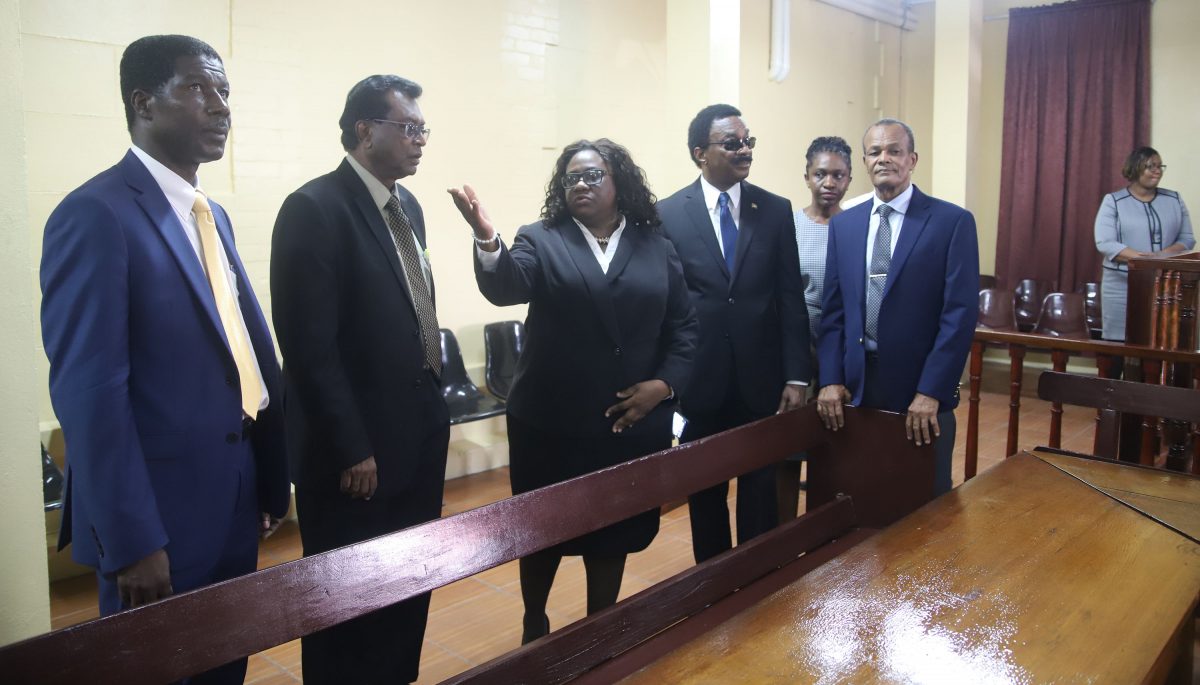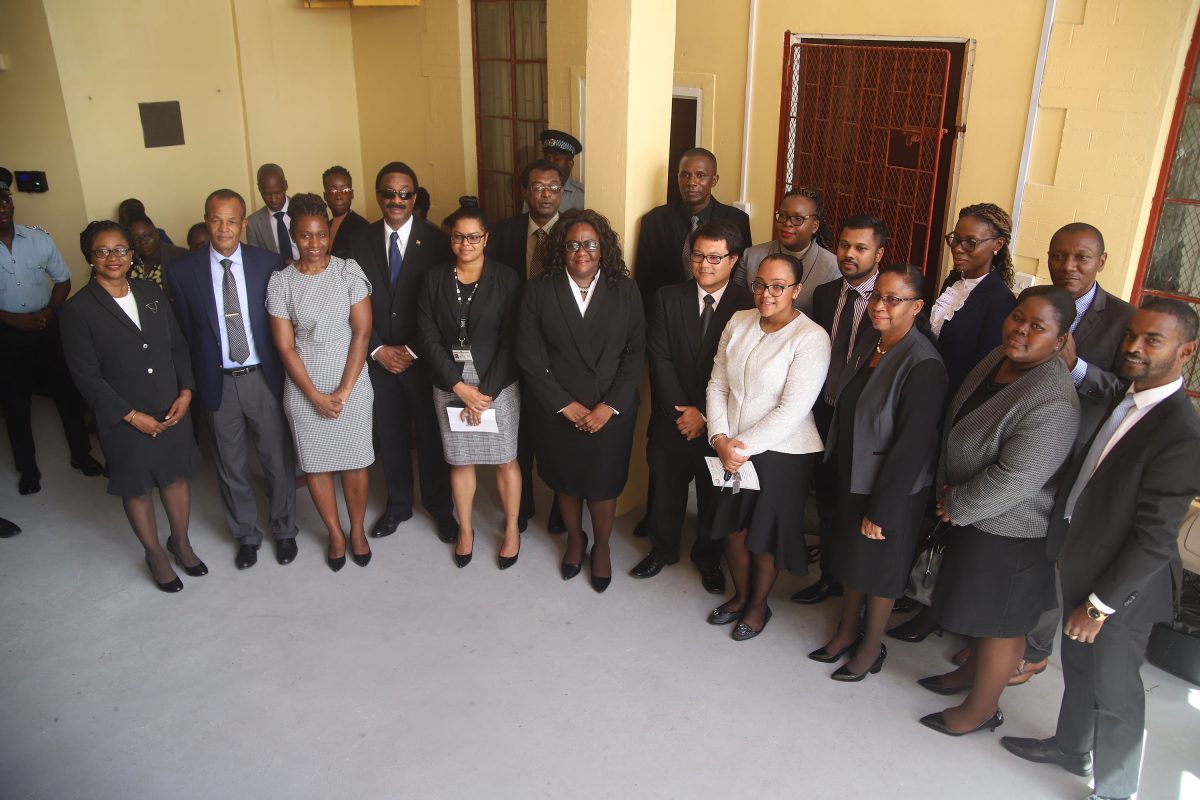Guyana yesterday opened its first Drug Treatment Court (DTC), which acting Chancellor Yonette Cummings-Edwards said could serve as a vehicle to lead persons who are grappling with substance abuse disorders away from the prisons to a place of recovery, rehabilitation and reintegration into society.
Long in the making, the court is located in the refurbished courtroom on the ground floor of the Georgetown Magistrates’ Courts compound. The refurbishment was done to the tune of just under $1 million.
Six magistrates have undergone intensive drug rehabilitation training in the United States with funding from Guyana’s international partners, such as the Organisation of American States (OAS) and the Inter-American Drug Abuse Control Commission (CICAD).

“This is just a pilot court, a small step by a step in the right direction, for as someone said it is better to take small steps in the right direction than to take a giant leap forward and only stumble backward,” the acting Chancellor told the large gathering of judges, magistrates, diplomats and others who were present to witness the historic opening.
Also playing a part in the opening of the court were Attorney-General Basil Williams and Minister of Public Security Khemraj Ramjattan, who both also addressed the gathering.
Explaining the basis for the court, the acting Chancellor cited the number of arrests, the cost of incarceration, the high level of recidivism, the need to have public health approaches to drug addiction as well as the backlog in criminal court matters. She also noted the need to have justice in collaboration with treatment, which is expected to be more effective in dealing with a criminal offender, especially one who has a substance abuse disorder.
Explaining how the court will work, the acting Chancellor said that on a guilty plea or upon being found guilty of certain specified drug-related offences, the offender will be provided with the option of a custodial sentence or to enter a treatment programme as an alternative to incarceration.
She pointed out that participation in the programme is voluntary and added that some of the prescribed offences will be discussed and included in the policy document to be circulated. It is expected that the treatment provided will be tailored to the needs of the offender and some of the key interventions will be educational sessions, one to one counselling, group counselling, drug testing, treatment recovery plans, reintegration and post-graduation plan.
The treatment organisations to be incorporated in the court will be the Salvation Army, Phoenix Recovery Programme and Social Life Issues Guidance and Counselling Services.
The Supreme Court will be working with the organisations along with other stakeholders to ensure the success of the court. The court will also have a drug treatment team that will be comprised largely of the magistrate, state counsel, defence counsel, probation officer, a representative from the approved substance abuse rehabilitation provider, a case manager and such other person that the court may direct.
“The team [will be tasked] with conducting the initial assessment or eligible participation and to provide an update to the court regarding the participant in the system,” Justice Cummings-Edwards said, before adding that once the participant signs a written agreement, which will be explained to them, they are required to comply with certain conditions and certain terms of the programme.
For example, the participants have to attend regularly and complete a drug abuse treatment programme for a specified period, and they have to submit to routine and random drug tests. Violations of the conditions by participants or if they have not performed satisfactorily or have not benefitted from the programme can result in sanctions being imposed
Sanctions could include extension of their time in the programme, changing the conditions of bail, increased drug testing, court appearances and/or supervision. In severe circumstances of violation of the conditions imposed, there could be revocation of the bail or expulsion from the programme. Should this happen, the participant will be transferred to the original court, where he/she would be sentenced in accordance with punishment set out for the offence.
In the same way that non-compliance attracts sanction, compliance attracts incentives or commendations being given to the participants. The programme for the participant is terminated based on the recommendation of the treatment provider and the drug treatment team or if the participation requests such termination. After the termination of a prescribed programme, the participant is taken before the court and the successful participant’s case will be disposed of by the magistrate, possibly by a fine or probation, and the participant will be eligible for graduation.
Graduation is based on the positive recommendation from the drug treatment team that the participant completed all the necessary requirements and is ready for graduation.
“The drug treatment programme is seen as an intervention rather than a sentence. It is a holistic approach by the court, by social services, the police, the defence counsel, medical services…and everyone working together to help the offender,” the acting Chancellor said.
She noted that Guyana did not reinvent the wheel but instead drew from the experiences of other treatment courts in other countries.
‘Not an ivory tower’
Justice Cummings-Edwards pointed out that the law operates within a social framework.
“Our courts do not operate in a vacuum; the court is not an ivory tower, our magistrates do not sit in a state of privileged seclusion separated from the facts and practicalities of this real world, neither do they bury their heads in the sand like ostriches,” the acting Chancellor said.
She said magistrates and judges are there to serve members of the public and part of this service is their collective response to crime, to wrongdoing and in doing so they must be socially effective.
It was noted that the courts have the mandate of enforcing the law and even finding distinct ways in so doing. According to the Chancellor, 90% of criminal matters are dealt with and determined in the Magistrates Courts and a large number of these are for drug offences or drug related matters. And many of the offenders, she noted, have substance use disorders and some also have mental health disorders.
“The grim reality is that when these offenders are charged and brought to the court and once found guilty they are likely to be incarcerated. While in prison the drug problem remains, when they are discharged they go back to the base as it were and again they appear before the court with similar offences and they are labelled recidivists,” she stated.
“In Guyana today, treatment court is an idea whose time has come…,” the Chancellor said, before adding that no longer can the idea of a drug rehabilitation court in Guyana be resisted.
She noted that countries in which drug courts exist have hailed it as the most single successful intervention for helping persons with substance use out of the justice system into lives of recovery.
‘New beginnings’
Meanwhile, OAS Representative to Guyana, Ambassador Jean Ricot Dormeus said yesterday’s opening will go down in Guyana’s history as one of new beginnings.
“We are launching the Drug Treatment Court to bring hope to many victims of drug abuse and numerous families in Guyana. We are culminating a painstaking process of regional cooperation, training and coordinating. We are giving birth to a new structure that will contribute to optimise the distribution of justice and improve peace and security in our society,” the ambassador said.
He said the journey to yesterday’s opening has gone through acquainting stakeholders with the model while a drug treatment court is in session in different states in the US and disclosed that the intricacies of the model saw former judges and court officers from the US, Canada and the Caribbean engaging in talks with stakeholders in Guyana, networking, training workshops using practical documents and mock sessions.
Guyana, he said, has joined other countries in the Caribbean such as Trinidad and Tobago, Barbados, Jamaica, St Lucia and The Bahamas in adopting the Drug Treatment Court model.
“Imagine how many apparently lost cases we can bring back to a vibrant life thanks to the operations of the DTC. Imagine how many families we can help restore thanks to the operations of the DTC. Imagine how much more productive our society can become thanks to the operations of the DTC,” he added.






